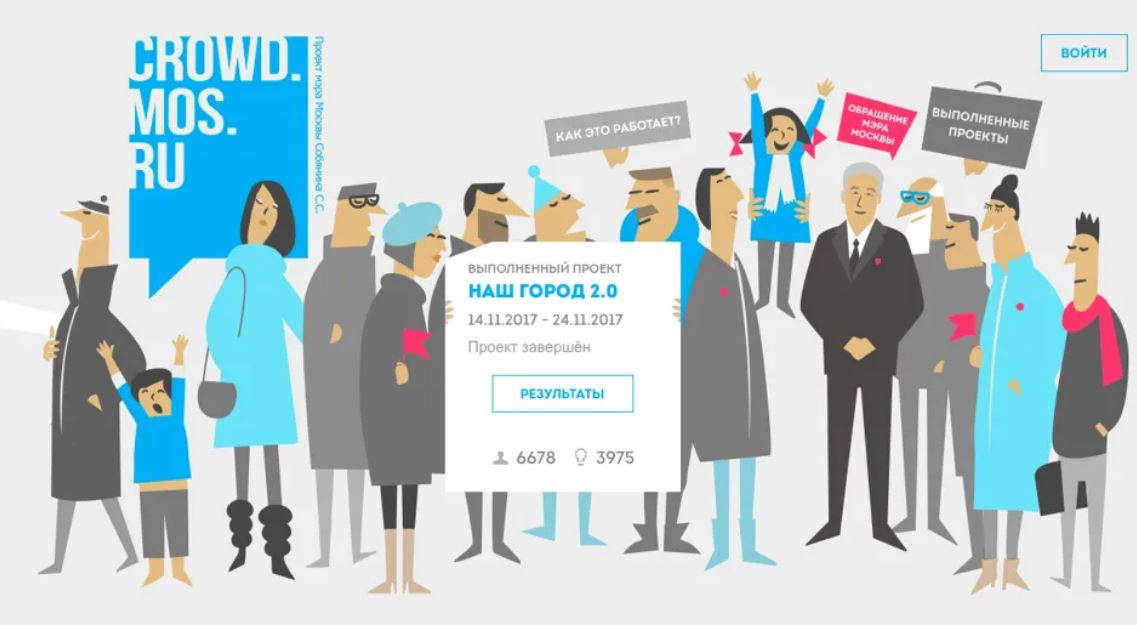by Alexander Pölz
Forms of direct democracy have been on the rise in the last two decades. One particularly interesting example is Moscow, where the municipal government implemented forms of e-participation in their governance by letting the public vote on specific issues, like urban development planning and transport (Schlaufer 2021: 824). After registering via phone number, citizens can vote on the platform Active Citizen (the proposed English translation for Aktivnyi Grazhdanin) in multiple-choice referenda and are even rewarded points for participating (Lunevich 2019: 86).

This platform caught my eye, as, to my knowledge, there are no similar widely used forms of online participation in Austria that would match this level of influence on governance. While I was initially excited to learn more about possibilities of giving the public a say in local politics, the article claims that the municipal government in Moscow implements participatory elements without challenging “the distribution of decision-making power” (Schlaufer 2021: 821), which still lies solely in the hand of the local authorities, as (among other things) all the choices are pre-defined by governmental actors. This made me question the need to establish such a form of participation in the first place, leading to the broader question: Is online participation something democracies should be striving for, something from which democracies could benefit?
In this short post, I want to first highlight some aspects Schlaufer (2021) mentions that would make the purpose of such a technology questionable, whereafter I shortly express theoretical considerations on how to meaningfully implement online participation in a democratic and just way.
Online Participation on Active Citizen
Though the strategy of implementing direct forms of democracy appears to be in line with attempts of other governments, Active Citizen can be viewed as an extreme case in regards to legitimacy claims. Building up on the legitimacy model by Scharpf (1998), Schlaufer (2021: 822) distinguishes three interdependent types of legitimation: input-based, output-based and discourse-based. Whereas input-based legitimation is grounded in the accurate representation of citizens’ preferences, output-based legitimation takes the usefulness of a policy for the public as its primary marker. For the discourse-based legitimation, the creation of a “collective identity” and a “compelling narrative” (Schlaufer 2021: 826) is necessary.
On a very surface level, it sure seems like online participation would be inclusive: Citizens can more easily make their voice heard and partake in the making of policies. This allows people to play a role in (co-)creating the city/society they want to live in and thereby have an effective impact in local politics. Additionally, a study by Kim and Lee has shown that e-participation can (among other things) lead to a higher assessment of government transparency and higher levels of trust in the government that holds online elections on issues (2012: 825-826).
Counterintuitively, the policies that people get to vote on on the Moscovian platform Active Citizen actually do not make a big difference (Lunevich 2019, Gritsenko / Indukaev 2021, Schlaufer 2021). On the one hand, they have been selected by the government beforehand, meaning that only those alternatives, that the local government would already agree on, are even eligible for being selected (Schlaufer 2021: 823-824), which helps the government maintain and increase control over policy domains (Gritsenko / Indukaev 2021: 1111) and can be seen as a form of censorship. For instance, Moscow citizens could elect the hill on which a monument for ‘Vladimir the Great’ could be erected, but not whether it should be erected or not (Lunevich 2019: 88). Many of the issues people get to vote on have also been described as “inconsequential” (Gritsenko / Indukaev 2021: 1122), as some of the policies are basically set in stone or are only symbolic (like the re-naming of streets) which puts the value of such a form of participation into question. By appearing more democratic in this specifically technological way, many young people (who commonly show lower turnout numbers in traditional forms of elections) are engaged on Active Citizen. While some feel more involved in the making of urban planning, others do express concerns about not voting on relevant issues (Lunevich 2019: 89).
Another aspect is the question of who is even eligible and able to vote on such platforms. While local authorities claim that 2.2 million users are registered on Active Citizen, it requires both technological knowledge to participate and people need to constantly be aware of upcoming issues, which in turn requires time and resources some people might not be able to expend (this relates to arguments of delegating power to politicians, commonly brought forth against forms of direct democracy).

Thus, in the case of Active Citizen, the three legitimation strategies identified by Schlaufer appear to only play mostly a surface-level role: On the one hand, the platform has been described as a “public opinion survey tool” (Schlaufer 2021: 830). Because of the way it is implemented, the platform does not challenge the decision-making power, while pretending to do so. On the other, as the platform can produce numbers that show responsiveness to the citizen’s desires, the municipal government can portray “success stories of improved urban policy performance” (Schlaufer 2021: 831), thereby simulating an increase in output-based legitimation. In terms of discourse-based legitimation, Active Citizen can be considered part of a modernization attempt by local authorities, with which the government without much success tries to appear digitized and responsive (Schlaufer 2021: 831).
How to implement it fairly
While it seems to me that Active Citizen does not live up to the promises of more participation, it does indirectly tell us what such participation could look like. The following list provides some considerations of what a fair implementation might include:
- Regarding the question of participation, it should be noted that while it is encouraging to hear that young people seem to be interested to engage in this newer form of governance, online voting does require technology (smartphones / laptops, internet, and the knowledge to operate these) to function, excluding certain groups, like non tech-savvy people, areas lacking the technological infrastructure, or citizens who are simply not interested in using digital technologies in this way. If, as the result of a broad societal dialogue, a community considers e-participation beneficial and such technologies were planned to be implemented on a bigger scale, these issues would also have to be addressed (for example, one might consider organizing info events for people lacking the necessary technological knowledge; or holding complementary in-person referenda in local community centres).
- The public should also have a reasonable chance to propose legislation that goes beyond what is already planned by the authorities, thereby enabling citizen input (Schlaufer 2021: 822), so that the “interaction between citizens / civil society and the authorities is horizontal and multidirectional rather than one-directional from the top down” (Linde / Karlsson 2013: 279). This might even go beyond submitting additional answers: One might also consider it desirable to have referenda on proposals from nongovernmental actors.
- Citizens should also have a say in the design of the system, as it would increase the democratic value of the whole process if they had a chance to contribute on multiple levels (e.g. in regards to inclusivity / accessibility).
- All this builds on the assumption that e-participation is generally something desirable, which is not necessarily the case. Hence, the conditions and the modes under which e-participation should be introduced need to be a topic of participatory debate themselves.
To sum up, there certainly is potential in direct forms of democracy, like e-participation on local issues; but the Moscovian case highlights several limitations of such participation, and while some might consider these constraints to be especially pronounced in electoral autocracies or non-democratic countries (Linde / Karlsson 2013, Kneuer / Harnisch 2016), they reveal potential shortcomings of the democratic value of forms of direct democracy more broadly, as they might also translate to (for example) liberal democracies and supranational entities, like the EU. So to be a technology worth implementing, e-participation should aim to be more than a legitimacy-cover for governments / supranational entities and for policies that are already decided.
Alexander Pölz is a master’s student in Epistemologies of Science and Technology at the University of Vienna, with a background in political science, Scandinavian studies and philosophy. His work explores political epistemology, non-human agency, and ethical implications of technology. In his spare time, he is a film enthusiast and passionate trading card gamer.
References
Gritsenko, Daria / Indukaev, Andrey (2021): “Digitalising City Governance in Russia: The Case of the ‘Active Citizen’ Platform”, in: Europe-Asia Studies 73(6), 1102-1124.
Kim, Soonhee / Lee, Jooho (2012): “E-participation, transparency, and trust in local government”, in: Public Administration Review 72(6), 819-828.
Kneuer, Marianne / Harnisch, Sebastian (2016): “Diffusion of e-government and e-participation in Democracies and Autocracies”, in: Global Policy 7(4), 548-556.
Linde, Jonas / Karlsson, Martin (2013): “The Dictator’s New Clothes: The Relationship Between E-Participation and Quality of Government in Non-Democratic Regimes”, in: International Journal of Public Administration 36, 269-281.
Lunevich, Iryna (2019): “(Dis) Empowering Technologies? Social Construction of Electronic Participation Tools”, in: Perekrestki 1, 79-100.
Scharpf, Fritz W. (1998): “Interdependence and democratic legitimation”, in: MPIfG Working Paper 98(2).
Schlaufer, Caroline (2021): „Why do nondemocratic regimes promote e-participation? The case of Moscow’s active citizen online voting platform”, in: Governance 34, 821-836.


